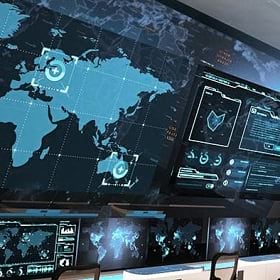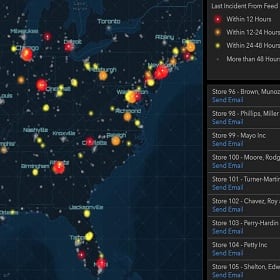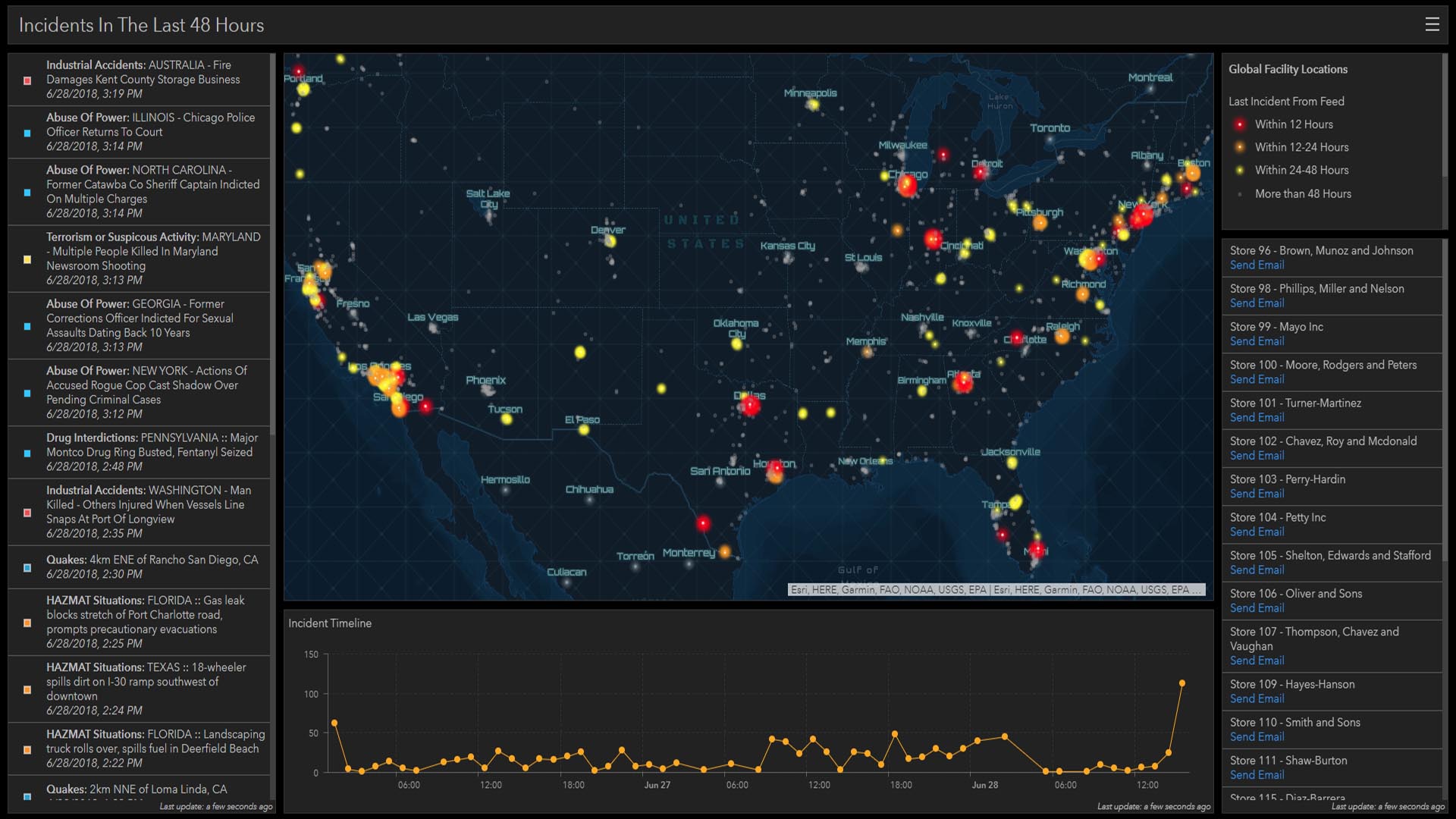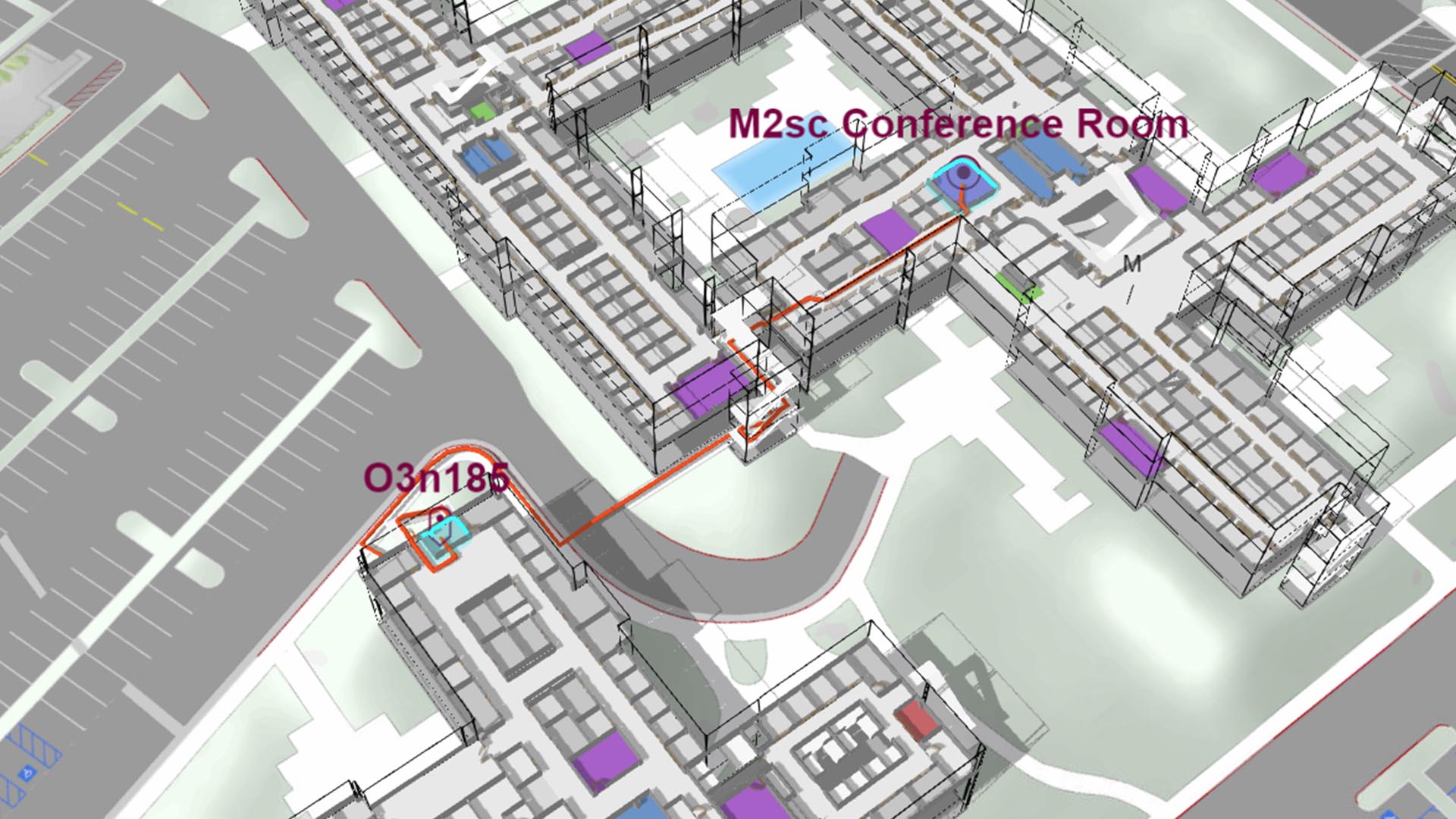“We live in a volatile world,” says Steve Marshburn, a consultant with Esri Professional Services. In the latest installment of the WhereNext Think Tank series, Marshburn talks to Esri’s Brian Cross about the state of corporate security. In a discussion that ranges from tracking executives to anticipating the impacts of planned and unplanned events, Cross and Marshburn reveal:
- How location intelligence creates situational awareness for corporate security executives and managers
- Why leading companies are looking at a “single pane of glass” to manage security
- How tools such as artificial intelligence and predictive analytics help companies manage risk
Brian Cross: We’ve had a chance to talk about a variety of topics in this Think Tank series, from IoT and big data to cutting-edge technology in the retail sector. What’s interesting to me is the area you’ve been working on, which addresses a different kind of business priority: corporate security. What’s your general sense of corporate security? Is it front of mind for business executives?
Stephen Marshburn: We live in a volatile world, and business operations are increasingly susceptible to severe weather, acts of terrorism, active shooters, and other unpredictable threats. In that climate, a lot of executives are increasing their focus on risk mitigation, and corporate security is a significant part of that.
The progressive corporate executives we talk to are working on initiatives that help minimize risk and create a resilient organization. That’s especially true for companies that have trade, supply chains, employees, partners, and assets spread around the world.
The two main threat types they face are threats to the safety of key corporate assets and to business continuity. Most events affect both in some way, so executives want to be well aware of those threats and well-prepared to react.
The Location of Risk
Cross: What role does location intelligence play in managing a company’s risk?
Marshburn: For managers and executives, location intelligence is all about understanding where their assets are and where the threats are. Those assets can be facilities; moving assets like a fleet of cars, trucks, or planes; or even human resources. The location of those assets has a big impact on their security and productivity.
Take banking. The United States alone averages nearly 12 bank robberies every day. A robbery can threaten employees’ personal safety as well as the company’s ability to serve its customers. When a branch is shut down due to a robbery, it has a major impact on business continuity.
The same is true of a weather catastrophe, a terrorism event, or an active shooter incident. Those are really complicated, dangerous situations that can affect employees, business locations, and company assets.
So decision-makers want location intelligence that shows which of their assets could be impacted and where. That’s always top of mind for the executives I advise—that, and how to return the business to normal operations as quickly as possible afterwards.
New Data Increases Awareness
Cross: Besides the increased attention it’s getting, what’s changing now for corporate security? What kinds of innovations are these executives enlisting?
Marshburn: Organizations have a lot of new technology at their fingertips, including data feeds and data viewers for real-time location intelligence and situational awareness.
Retail companies can view incident feeds of events happening in a certain area to see if their stores are affected. Managers and executives can view flight maps to see if something is disrupting flight patterns and travel schedules. They can tap into IoT sensors—flood gauges, motion-activated security cameras—to understand the situation on the ground in locations that matter to them.
With that data comes the challenge of making sense of it. I’ve noticed that a lot of executives are at a tipping point. They’re saying, “Okay, we have the data. We have at least a basic sense of where our assets are. Now how do we put all of this together and understand the relationships between the different components?”

In typical corporate security command centers, I see analysts trying to keep up with data streams on many screens. In cutting-edge command centers, I see analysts monitoring the organization’s status on a single pane of glass.
Location Intelligence through a Single Pane of Glass
Cross: They seem to be looking for what you describe as a “single pane of glass.” Could you explain that?
Marshburn: When I walk into a command center for a typical corporate security team, I see a lot of these data feeds streaming on separate screens. The analysts are monitoring data sources that are disconnected from one another, disconnected from the company’s organizational data, and not clearly connected to physical locations.
When I visit cutting-edge command centers, the information tends to be similar, but the view is different. The analysts there are looking at what we call a single pane of glass. Essentially, on one screen, they see a holistic view of their organization—its facilities, moving assets, personnel, and vendors and partners in the supply chain. All that information is displayed in a single situational view. They’re viewing data like incident feeds and weather data layered into the map, with incident information in a side panel or a screen crawl, and valuable metrics about their organization’s health or potential risk in analytical panes below the map.
Cross: We know the human brain is good at seeing patterns in large volumes of data, but it seems like these data feeds could be overwhelming when analysts are trying to establish situational awareness across a large number of assets.
Marshburn: Analysts in the command center are trained to look for important events that might impact company assets, but there are a lot of things happening around the globe. You’re right, it can be a little overwhelming—even when it’s all on a single pane of glass. That’s why alerting is important.
Modern geographic information systems [GIS] use artificial intelligence and predictive analytics to identify which disruptions or potential disruptions will intersect with an organization’s assets and where, and alert the analyst to that threat. That way the single pane of glass automatically displays only what matters.
That helps the security team understand the situation quickly and move to the decision-making phase almost immediately.
Cross: Can you give us an example of the single pane of glass in action?
Marshburn: One scenario companies face fairly often is the planned demonstration. It’s interesting to note that four of the five largest protests in American history took place within the past two years. Event organizers are using social media to coordinate demonstrations in multiple cities simultaneously. That can disrupt business operations for national brands, so corporate security teams need to understand and manage multiple threats.
On a single pane of glass, they can monitor video feeds of business locations near the demonstration, learn about any escalated activity from local law enforcement streams, track social media postings from the event, and see status reports from managers of locations along the route. That level of situational awareness helps the business keep employees and customers safe—and restore business operations quickly if any unexpected disruptions arise.
Or consider the case of a hurricane. We all know what it’s like to try to anticipate which cities are going to be hit by a major storm. If you’re an executive for a retail chain, you’re pretty aware of where your stores are, where your distribution centers are, and where the hazard is moving.
But some security executives are taking that to the next level to create a new kind of location intelligence. For example, they’re using GIS and IoT data to predict in near real time where the floodplains will be the day after the storm, and display that on a single pane of glass. Then they can make decisions to protect employees and customers.
They’re using the predictive analytics and artificial intelligence baked into GIS to understand which of the company’s stores will need to be resupplied, and how to coordinate with distributors to manage that process. They’re anticipating which locations will likely close, and alerting employees and customers to contingency plans.
That kind of predictive location intelligence helps companies act quickly when time is extremely valuable.

The idea behind the single pane of glass is the ability to reduce decision-making time by understanding if there's a threat to your organization—and being able to act on it.
The Industry Perspective on Corporate Security
Cross: So far we’ve talked about banks and retail locations. Are companies in other industries using location intelligence for security?
Marshburn: We’re beginning to see it applied to field workers in high-stress environments—manufacturing plants, offshore oil rigs, energy complexes. In some situations, those workers literally fasten a padlock to a fence to indicate whether they’re in or out of a facility. Imagine experiencing a security threat or a natural disaster and having to send a manager to a wall of padlocks to figure out which employees are in the space.
Location positioning and GIS technology are changing that. Managers and executives can now see on a computer screen or a mobile device where employees are in real time. Security managers can immediately notify all employees in a particular area if there’s a threat they need to get clear of.
We’re even seeing a version of location tracking at the corporate level, with some companies monitoring their executives as they travel around the globe. [See the Think Tank interview IoT and Big Data Get Real for more on executive tracking.]
And of course, tracking is important in the supply chain. Organizations with moving assets—finished goods, rail cars, trucks—they’re using location awareness to reroute supplies around areas of instability and avoid major business disruptions.
Taking It Inside
Cross: You’re describing organizations with people and assets spread far and wide. But we’re hearing about companies using these techniques indoors as well.
Marshburn: Right. The principles are the same; they’re just applied on a smaller scale. Companies that originally mapped their facilities to improve maintenance operations and promote employee productivity are now using that indoor location awareness to improve security.
One executive I talked to had a 911 call recently on his campus. It was late at night, and he spent half an hour running through various buildings, trying to find the person who called 911. In the end, the person turned out to be fine, but it underscored for the executive the need to be more aware of where events occur in the workplace. Today’s GIS and smart-mapping technology gives executives a much richer understanding of the spaces where people work every day.
Assessing the Business Value
Cross: Can you bring this back to business value? What is the value of managing corporate security, or the risk of not doing it?
Marshburn: Executives tell us there’s significant business value in having the location intelligence we’ve been talking about—especially the predictive kind. The hurricane scenario is a good illustration. If executives can predict which stores and distribution centers should close—and just as important, which ones shouldn’t—they can safeguard their people and assets and avoid needless closures that cost the company sales.
They can also shift operations. Banks can redirect cash flow to the right ATMs and branches. Grocery and retail stores can make supply chain adjustments to send products to locations where customers will need them. All of this helps meet customer needs, and helps the business maintain operations and safeguard revenue.
Once the incident has passed, we see companies creating after-action reports to adjust future procedures. Instead of executives making those adjustments based on spreadsheets or Word documents, they’re looking at a spatial view of how their organization reacted during recent events, and understanding what could be done better next time.

When executives can access real-time location intelligence, they can match their organizational risk with the most effective response.
What’s Next in Corporate Security
Cross: I can see the gravity of what these companies are doing and the impacts it’s already having. But what’s next? Where does corporate security go from here?
Marshburn: The inflow of data—especially IoT data—will continue to increase. At the same time, the ability of AI and predictive analytics to deliver intelligence, not just data, will improve too.
The biggest change, I think, will be in execution. Technologies like GIS that deliver location intelligence and predictive analytics will be better integrated with the operational systems that trigger action. So if there’s an active shooter incident in a certain part of town, GIS might inform the delivery system, which will update the routing for drivers in the area based on their real-time location. Similarly, when a weather event—like a wildfire, flood, or hurricane—threatens certain geographic areas, location technology will be able to coordinate with supply chain management software to reroute goods and coordinate rush orders from suppliers outside the affected area.
There will be human checks on the system, of course, but humans alone can’t make sense of all the data that goes into supply chain planning. And they certainly can’t replan all those activities in real time.
The good news is that we’re reaching the point where security executives won’t say, “We realize something’s happening—now let’s execute the operational plan.” The systems themselves will sense the threat and make adjustments to minimize risk.











